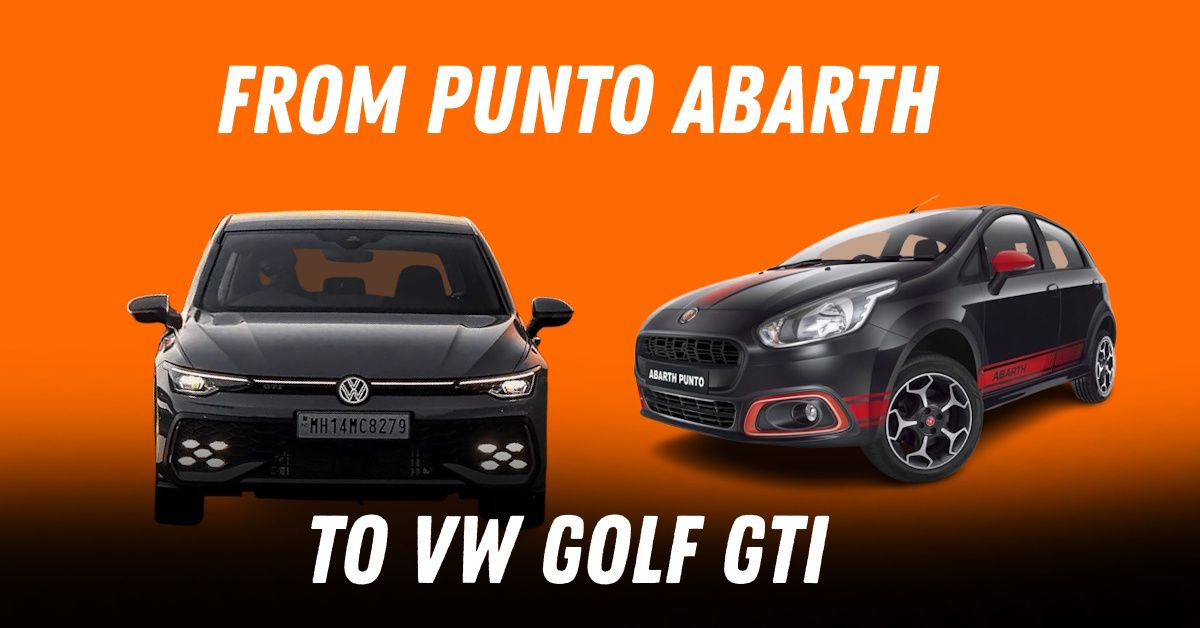When ₹50 Lakh Makes More Sense Than ₹10 Lakh: VW Golf GTI vs Fiat Punto Abarth Paradox


The automotive world thrives on contradictions, and few are as striking as the contrast between two European hot hatches: the Fiat Punto Abarth and the Volkswagen Golf GTI. One launched at under ₹10 lakh and faded away almost unnoticed. The other, with a ₹52 lakh price tag, has sparked a wave of buyer enthusiasm before it even hits Indian roads.
The Golf GTI’s India debut isn’t just about launching a high-end hatchback. It highlights a market truth that’s hard to ignore: sometimes, spending five times more is not only justifiable, it’s the smarter choice.
Both the Punto Abarth and the Golf GTI are cut from the same cloth: compact, performance-focused hatchbacks built to bring everyday excitement. When the Punto Abarth arrived in 2015, it came armed with a 1.4-litre turbocharged engine good for 145 horsepower and 212 Nm of torque. It was fast, fun, and affordable. Fiat marketed it as a true enthusiast’s car, aimed at those who wanted performance without the premium badge.
In contrast, the new Golf GTI brings much more to the table. Its 2.0-litre engine churns out 265 horsepower and 370 Nm of torque, delivering a 0–100 km/h sprint in just 5.9 seconds. But beyond the numbers, it also comes with features like adaptive cruise control, a modern digital cockpit, and advanced safety tech, equipment that the Punto never had a shot at.
Yet despite the Punto’s performance pedigree and bargain pricing, it never caught on. Meanwhile, the Golf GTI’s 150 units were spoken for within days.
The Punto Abarth’s failure wasn’t because it lacked soul. It delivered serious thrills for its price, with sharp handling, a responsive engine, and four disc brakes as standard. On paper, it was a compelling alternative to much costlier cars.
But Fiat’s troubles in India ran deeper. Poor service reach, unreliable parts supply, and a declining brand image meant few were willing to take a risk. Even as prices were slashed and some dealers offered the car at ₹7.5 lakh, buyers stayed away. The final six units were bought by six friends, more out of nostalgia or loyalty than any validation of market demand.
The Golf GTI's success is about more than just performance stats. Volkswagen has earned buyer trust over time, with a stronger service network, more consistent after-sales support, and a global reputation for solid engineering. For those willing to pay ₹52 lakh, confidence in the brand is a key part of the deal.
Context matters too. In 2015, hot hatches were a niche interest in India. Today, the buyer base has evolved. There’s greater appetite for premium vehicles, and more awareness of what they offer. For many, the Golf GTI isn’t just a car—it’s an expression of taste and confidence in quality.
Volkswagen’s strategy to release the GTI in limited batches adds to the appeal. With only 250 units planned across two rounds, there’s a sense of exclusivity that enhances its desirability. This scarcity turns the GTI into something more than just a fast hatch, it becomes a status symbol.
The story of these two cars tells us something about how performance car buyers have changed. The old equation of “maximum horsepower per rupee” no longer dominates the conversation. Buyers now look for brand credibility, ownership support, resale prospects, and overall peace of mind.
This shift also mirrors broader economic changes. More disposable income and a more aspirational middle class mean buyers are willing to spend more for what they perceive as a safer, more rewarding experience. The Golf GTI benefits from decades of strong branding, while the Punto Abarth got lost in Fiat’s fading presence.
In the end, this isn’t just a comparison of two hatchbacks. It’s a reflection of how the Indian automotive landscape has matured. The Golf GTI may cost five times more, but to many buyers, it possibly represents five times the confidence, support, and satisfaction. And that’s a price they’re willing to pay.
As for Punto Abarth, it’s probably a bit of timing but also a lot of Fiat-issues that sealed its fate.